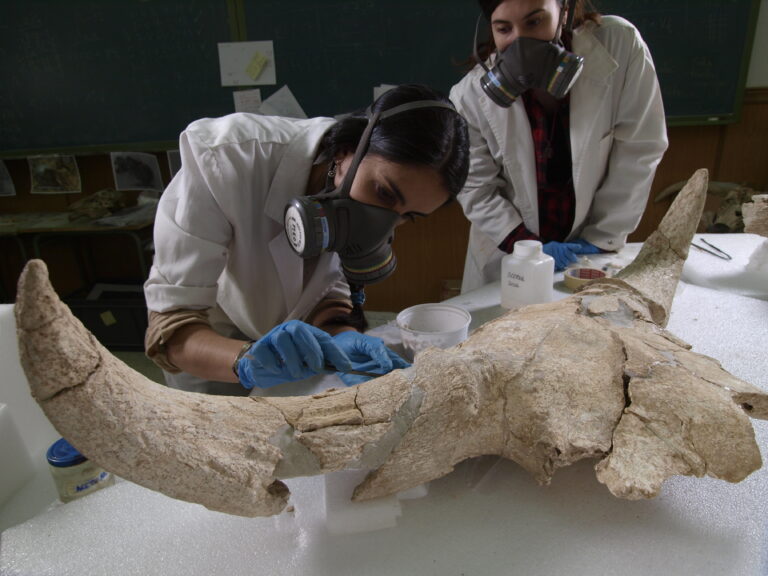The CENIEH participates in a study that confirms that the Neanderthals possessed symbolic capacity
Ana Abrunhosa, from the Centro Nacional de Investigación sobre la Evolución Humana (CENIEH), and Ana Isabel Ortega, from CENIEH and Fundación Atapuerca, form part of the research team that has just published a paper in the journal Nature Human Behaviour confirming that the Neanderthals possessed symbolic capacity. Analysis of the large herbivore skulls found at Cueva Des-Cubierta site (Pinilla del Valle, Madrid), reveals that these hominins, who lived in the region more than 40,000 years ago, used them as hunting trophies.
All the skulls found in this hunting sanctuary, including especially those of bison (Bison priscus), aurochs (Bos primigenius), red deer, (Cervus elaphus), and two from steppe rhinoceroses belonging to the species Stephanorhinus hemitoechus, were prepared by the Neanderthals following a single pattern: they removed the mandible and upper maxilla, consumed the brains, and left the part with the horns or antlers as though these were hunting trophies.
“We have been able to verify that this activity was kept up over several generations, if not longer, which leads us to conceive of a cultural tradition that would have been handed down over time”,
explains the Universidad Complutense de Madrid paleontologist Juan Luis Arsuaga, one of the authors of this paper, in which researchers from the CENIEH, the Universidad de Valladolid (Uva), the Universidad Complutense de Madrid (UCM), the Museo Nacional de Ciencias Naturales de Madrid (MNCN-CSIC), and the Fundación Atapuerca, as well as other institutions, also participated.

Together with these skulls, Mousterian stone tools, typical of the Neanderthals, as well as anvils and the hammerstones used to fracture them, also appeared. The raw materials they used were of local origin and highly varied (flint, quartzite, gneiss, etc.).
“The Neanderthals that exploited them knew how to make the most of each material, adapting their technology and needs to what was available, and showing that they did not depend on any particular kind of rock to develop their technology and for their daily activities”, explains Abrunhosa.
This behavior is not related to subsistence activities, but rather to others that furnish information on little-known aspects of the Neanderthals.
“Up to now, our species had been considered the only one with capacity to attribute concepts to symbols, but with these new findings, the theory needs to say that this intellectual attribute is shared with the Neanderthals”,
points out the lead author of this study, Enrique Baquedano, director of the Museo Arqueológico y Paleontológico of the Madrid Regional Government.
Cueva Des-Cubierta
This site is a long cave gallery whose ceiling has fallen in, that is, the original roof has been lost, and an exceptional assemblage of large herbivore skulls, some of them associated to small fires, has been recovered here.
To date, there does not exist any other archaeological site anywhere in the entire range over which H. neanderthalensis extended that is similar to Pinilla del Valle. The discoveries at Cueva Des-Cubierta make it an exceptional place that is making it possible to unravel the keys to the behavior of this species that lived alongside H. sapiens.
“This study opens the door to a new conception of this hominin species and raises questions about our role as the only “sapiens” in the course of the evolution of life on this planet”,
adds Arsuaga, who is one of the directors of this project, together with Enrique Baquedano and the geologist Alfredo Pérez-González.
Bibliographic information:



